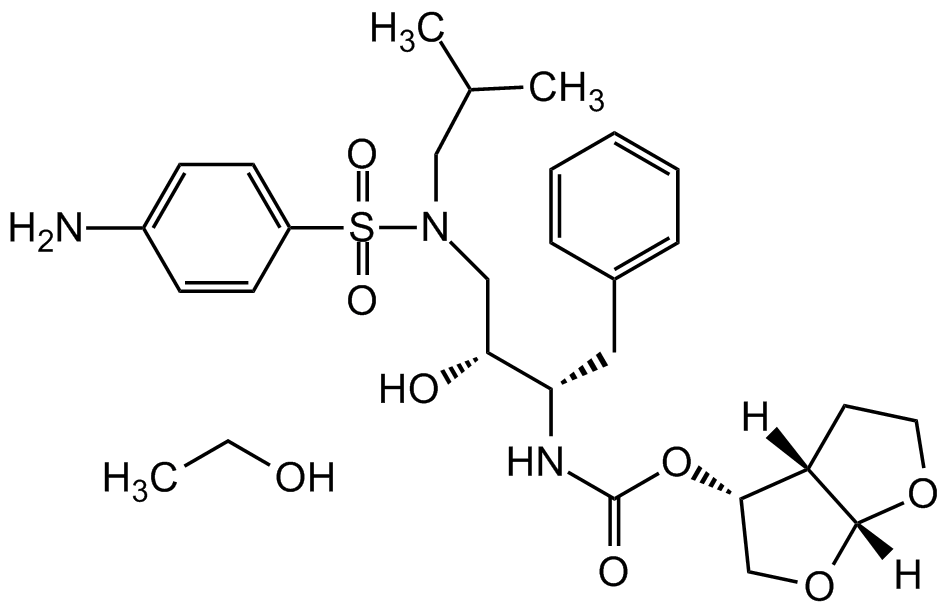Darunavir . ethanolate
| Code | Size | Price |
|---|
| AG-CR1-3724-M010 | 10 mg | £60.00 |
Quantity:
| AG-CR1-3724-M050 | 50 mg | £160.00 |
Quantity:
| AG-CR1-3724-M250 | 250 mg | £460.00 |
Quantity:
Prices exclude any Taxes / VAT
Overview
Regulatory Status: RUO
Shipping:
Ambient
Storage:
-20°C
Images
Documents
Further Information
Alternate Names/Synonyms:
TMC114; TMC41629; UIC-94017; HSDB 7788; Prezista
Appearance:
White to off-white solid.
CAS:
635728-49-3
EClass:
32160000
Form (Short):
liquid
Handling Advice:
Keep cool and dry.
InChi:
InChI=1S/C27H37N3O7S.C2H6O/c1-18(2)15-30(38(33,34)21-10-8-20(28)9-11-21)16-24 (31)23(14-19-6-4-3-5-7-19)29-27(32)37-25-17-36-26-22(25)12-13-35-26;1-2-3/h3-11,18,22-26,31H,12-17,28H2,1-2H3,(H,29,32);3H,2H2,1H3/t22-,23-,24+,25-,26+;/m0./s1
InChiKey:
QWSHKNICRJHQCY-VBTXLZOXSA-N
Long Description:
Chemical. CAS: 635728-49-3. Formula: C27H37N3O7S . C2H5OH. MW: 547.7 . 46.0. Darunavir ethanolate is a highly potent HIV protease inhibitor (IC50=3-6nM, depending on laboratory HIV-1 strain), an antiretroviral medication used to treat and prevent HIV/AIDS. The ethanolate formulation has some stability advantages compared to the free base Darunavir (Prod. No. AG-CR1-3712). Darunavir ethanolate is a second generation HIV-1 protease inhibitor that inhibits replication of various laboratory strains and clinical isolates of HIV-1, including those resistant to first generation protease inhibitors. It inhibits cell-free diffusion and cell-to-cell spread of HIV-1 in Jurkat cell populations. Formulations containing darunavir have been used in combination therapy for the treatment of HIV. Shown in a SARS-CoV-2 protease structure model study to potentially bind and inhibit the papain like viral protease (PLVP) of SARS-CoV-2, responsible for COVID-19.
MDL:
MFCD18251642
Molecular Formula:
C27H37N3O7S . C2H5OH
Molecular Weight:
547.7 . 46.0
Package Type:
Vial
Product Description:
Darunavir ethanolate is a highly potent HIV protease inhibitor (IC50=3-6nM, depending on laboratory HIV-1 strain), an antiretroviral medication used to treat and prevent HIV/AIDS. The ethanolate formulation has some stability advantages compared to the free base Darunavir (Prod. No. AG-CR1-3712). Darunavir ethanolate is a second generation HIV-1 protease inhibitor that inhibits replication of various laboratory strains and clinical isolates of HIV-1, including those resistant to first generation protease inhibitors. It inhibits cell-free diffusion and cell-to-cell spread of HIV-1 in Jurkat cell populations. Formulations containing darunavir have been used in combination therapy for the treatment of HIV. Shown in a SARS-CoV-2 protease structure model study to potentially bind and inhibit the papain like viral protease (PLVP) of SARS-CoV-2, responsible for COVID-19.
Purity:
>98% (HPLC)
SMILES:
NC1=CC=C(S(=O)(N(C[C@@H](O)[C@H](CC2=CC=CC=C2)NC(O[C@H]3CO[C@]4([H])[C@@]3([H])CCO4)=O)CC(C)C)=O)C=C1.CCO
Solubility Chemicals:
Soluble in DMSO (30mg/ml). Very slightly soluble in water (~0.15mg/ml).
Transportation:
Non-hazardous
UNSPSC Category:
Biochemical Reagents
UNSPSC Number:
12352200
Use & Stability:
Stable for at least 2 years after receipt when stored at -20°C.
References
Potent HIV protease inhibitors incorporating high-affinity P2-ligands and (R)-(hydroxyethylamino)sulfonamide isostere: A.K. Ghosh, et al.; Bioorg. Med. Chem. Lett. 8, 687 (1998) | Novel bis-tetrahydrofuranylurethane-containing nonpeptidic protease inhibitor (PI) UIC-94017 (TMC114) with potent activity against multi-PI-resistant human immunodeficiency virus in vitro: Y. Koh, et al.; Antimicrob. Agents Chemother. 47, 3123 (2003) | Darunavir: a second-generation protease inhibitor: K.H. Busse & S.R. Penzak; Am. J. Health Syst. Pharm. 64, 1593 (2007) (Review) | Darunavir (TMC114): a new HIV-1 protease inhibitor: J.M. Molina & A. Hill; Expert. Opin. Pharmacother. 8, 1951 (2007) (Review) | Darunavir: a nonpeptidic antiretroviral protease inhibitor: C. McCoy; Clin. Ther. 29, 1559 (2007) (Review) | Protease inhibitors effectively block cell-to-cell spread of HIV-1 between T cells: B.K. Titanji, et al.; Retrovirology 10, 161 (2013) | Polymorphic stability of darunavir and its formulation : J. Chaves, et al.; J. Therm. Anal. Calorim. 123, 2185 (2016) | Molecular Modeling Evaluation of the Binding Effect of Ritonavir, Lopinavir and Darunavir to Severe Acute Respiratory Syndrome Coronavirus 2 Proteases: S. Lin, et al.; (Epub ahead of print) (2020)



